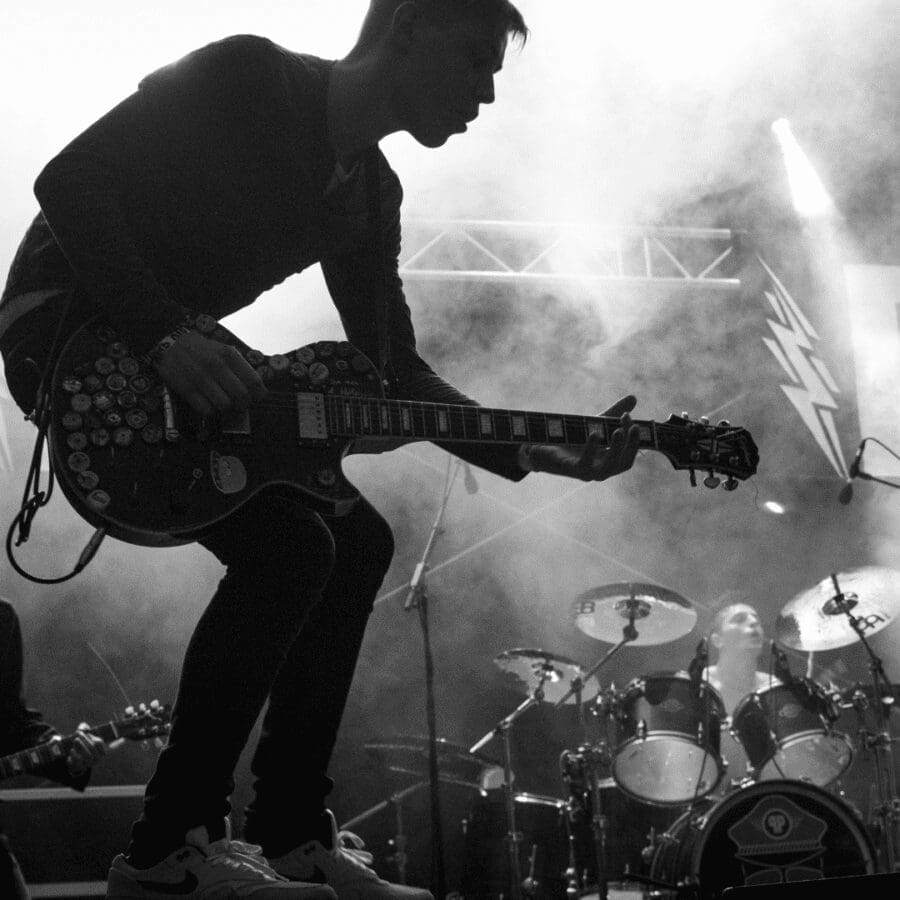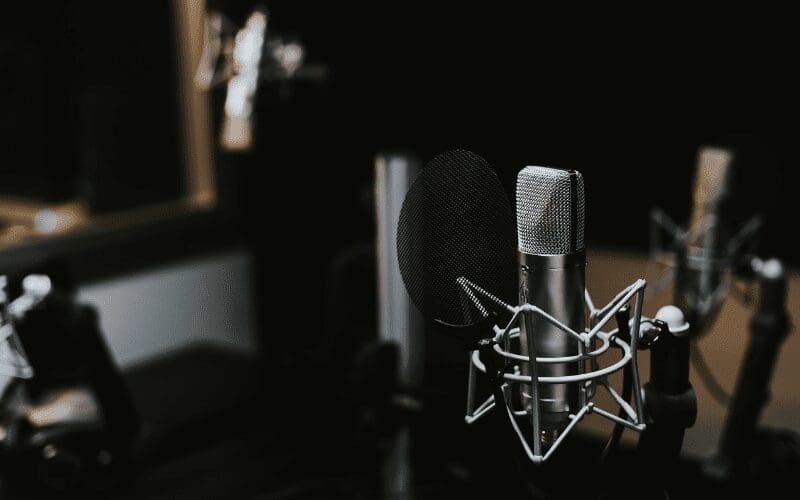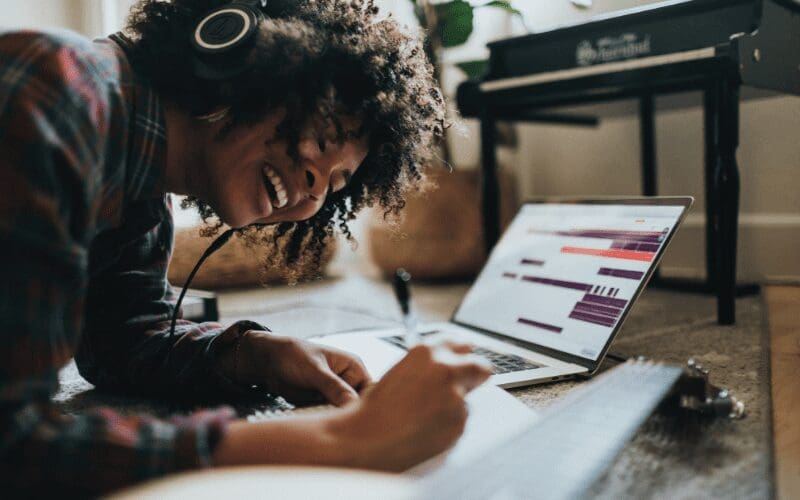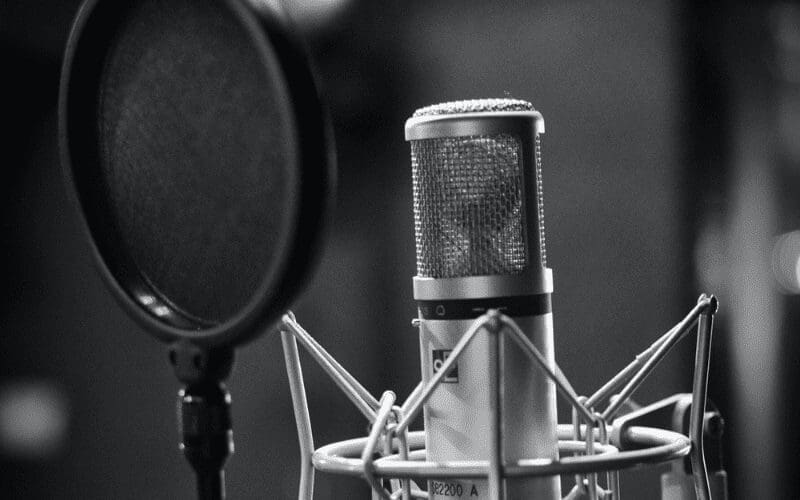Starting out with music production can be overwhelming. You might be familiar with certain aspects, like how to record music, or mixing and mastering. However, you’re probably here because you have some questions on how to get started. This article will cover the main principles around how to start out, what equipment you need, and some top production tips. I will guide you through music production for beginners, talk about everything from music mixing and mastering, to what dither is and how to get into music production, and discuss how to get started in producing music for beginnings to jumpstart your career.

Not so fast – We can help!
Do you need help accelerating your career?
Grow your earnings and audience with Artist Development
Learn moreWhat Is Music Production?
Music production is the process of managing and overseeing the recording and production of a track - from writing the first lyrics and melodies to mastering the finished track. There are various different forms of production, from track production to toplining, or even solely mixing and mastering. I will be looking at the creation of an entire song, from writing to mastering, I will be looking at these six stages:
- Songwriting
- Arrangement
- Tracking
- Editing
- Mixing
- Mastering
Before we go into detail about the different production stages, let’s take a look at the equipment needed.

Music Production Equipment
To learn how to produce music for beginners, you will need the necessary equipment to create a finished track. I’m going to give my top tips and advice on a home studio music production setup.
The music production technology market is flooded with tons of tools (both software and hardware). I’ll start off by giving you the basic equipment checklist to start producing. Contrary to a lot of opinions, you don't need to start out with the highest quality tools out there!
Main Components Of A Starter Setup

Computer
A computer (desktop or laptop) is a necessity to host your music production software (DAW). You don't have to start out with the newest Macbook Pro model - the best computer for music production is the one you can afford. Almost any PC model in the $500-800 price range might do. If you are a Mac person, look for used Macbook Pro models from 2012-2014 in the $800-$1000 range. Choose at least an Intel Core i5 Processor and if you can afford it, 16 GB RAM.
DAW
The Digital Audio Workstation (DAW) is the program on your computer or laptop where you will write, produce, record, mix, and master your music. The choices here are plenty, and it’s a matter of taste and workflow.
It’s quite likely that you will stick to the DAW that you choose first - but with companies such as PreSonus offering free trials, it’s worth trying a few to see which feels best.
The Digital Audio Workstation doesn't make you a better or worse songwriter. A producer friend of mine from Germany wrote, produced and mixed whole albums on GarageBand, so there are no excuses!
I recommend some of the major DAW's out there for someone who is just starting out:
- Apple Logic Pro
- Steinberg Cubase
- PreSonus Studio One
- Ableton Live Lite
Audio Interface
An Audio Interface serves 2 purposes: being able to record music and instruments through microphones, or the line input, and to connect your monitor speakers or headphones to actively listen to what you are producing. Audio Interfaces are mostly connected through USB, and FireWire or Thunderbolt are popular connections for a Mac. Start out with a 2-input interface like the Focusrite Scarlett 2i2. You can record all kinds of instruments or vocals with microphones, and can even use the inputs to record electric guitar when connected directly.
Headphones/Monitor-Speakers
Studio headphones and/or monitor speakers are crucial for good results in music production. With a decent speaker or headphone setup, you can hear all of the frequencies levelled out equally. Hifi speakers or headphones emphasize one frequency over another too much, so don't use the cheapest headphones. You don't need $1000 headphones or monitor speakers either, though.
The most important thing about your speaker system is that you get to know it, and know how it sounds in the room. In my opinion, the best headphones for music production in price and value is the Beyerdynamic DT 770 Pro. You can also check out other great studio headphones here.

Microphone
This is not a must, but I highly recommend getting a decent microphone. An all-round mic like the Audio-Technica AT2020 is a good starting point. You can record your own vocals, guitar licks, piano, melodies, or even drums.
Plugins
Plugins are a great bonus! All of the DAWs mentioned above come with high-quality plugins for the production, mixing and mastering process. Just in case you want to up your game a bit, I'd start with a decent reverb, EQ, compressor and a mastering limiter.
Music Production Equipment Set Up
Now that you have all of the necessary tools, it's time to assemble it all and start your first track!
Your computer is the center of your new setup. This is where you develop your musical ideas in the arrangement and production steps mentioned above. All the music you record will be stored on it, and all of the mixing and mastering will be done on it, too. It is the hub of your work because all other facets will either be plugged into, or stem from the computer.
Your interface will connect to your computer via USB. It is the bridge between analog and digital work and works in both directions. All of the digital (inside the box) instruments, loops, and samples will go out through it to your headphones and monitor speakers.
Everything you record will go in either through the interface directly, or through the microphone which will be attached to the Interface as well. In both directions, in and out, the interface converts digital to analog and analog to digital signals.
As I already mentioned, your speakers and headphones will be attached to it, so you can hear what you're working on. If the interface is attached, you need to attach at least a pair of speakers or headphones - otherwise, you won't hear a thing.
Production
Everything is now set up properly. You can finally move on to the exciting part: the actual music production!
Let’s say you have an idea in your head - maybe a melody, or a beat. Now is the time to let it out and bring it to fruition!
Songwriting, arrangement, and production happen all at the same time. These days, with non-destructive recording and editing and the plethora of sounds, loops and plugins at our disposal within a single computer, the process is less linear.
I will list these steps in order, to give you a reference point and foundation. You can mix up the process, and find what works best for you. Often, when I produce a song, all of the steps mentioned below melt together.
Songwriting

There are various types of producers, and some of you may not be planning on writing songs - so feel free to skip this part if it doesn’t apply to you!
For this stage, you’ll want to jot down musical ideas. Try to use appealing melodic, harmonic and rhythmic concepts. Develop ideas with the beginning, middle, and end parts in mind - maybe even use voice notes to collect ideas.
A single beat or melody doesn't make a song, though. Start developing basic musical ideas, like harmonies and the different structural parts. Play around with melodies and partner them with different versions of harmonic structures.
Also, try playing melodies and harmonies with different instruments. What sounds out of place on a piano might sound great as a synth line. Lay the harmonies down with a pad and double the piano chords with it - it will be quite simple at this stage.
Lastly, have fun! Music-making should be an exploration, and lots of your best ideas will come out of playing around.
Arrangements in Music Production
So, your basic song parts are ready. Next up is the arrangement, which is crucial to a successfully produced song.
Choose instruments that influence the genre and style of the song, and organize the parts into the song structure you desire in-depth. Make sure you don't start out too loud on the individual tracks and push your faders down to about -6db. That way, you have enough headroom to add plenty of instruments and vocals tracks. This will also help you to have enough headroom on your levels for the actual mixing process.
Here are some brief tips on different sections of a song (also, check out our article on song structure for more information):
The Intro
This can either be a big bang or a gentle lead-in. Some producers use the signature hook and arrange it in a way that suits the intro, whereas some just use the harmonies of the chorus without the vocals or even solo vocals.
Verse
This is where the story that you are telling begins. Remember to use the lyrics to guide the listener through the story. To keep it exciting and interesting for the listener, add slight variations to the backing track in every verse (whether through virtual or recorded instruments).
Chorus
The chorus is the climax of a song, and the part everybody remembers. Coming from the verse, into the chorus the listener expects a change in either pace, dynamic or volume. Use new and distinctive instrumentation, and introduce new instruments that are featured only in the chorus that will function as a signature hook sound.
Bridge
This part typically comes after the second chorus and brings variety into the song. The bridge usually features a harmonic structure that hasn’t yet been heard in the song and features different lyrics.
Music Production Tips
Production is about the nitty-gritty details. Wondering how to mix music? Read on below...
Examples of this include finding the right transitions and certain build-ups within the structure. Look for all the little details that need ironing out, such as the off-harmony in the bridge, and so on. This is also the time to think about how the vocals should sound and start recording your own vocals to test your ideas out. You can use them for the final mix, or maybe have a singer come in and create vocals for you
Record Music
Recording music seems intimidating when you are just starting out. What if my recording space isn’t good enough? How do I set up the microphone to capture the instrument in a good way?
These are all legitimate questions, and in all honesty - you probably won't do it right the first time. Maybe not even the tenth time - but practice makes perfect.
I encourage you to start recording music right from the get-go, as there is a huge reward waiting for you on the other side of your insecurity. You will develop your very own style and voice much more quickly. And you will have a unique sound that will be different from anyone else (who uses the same plugins and presets).
If you start recording anything with a microphone, you need headphones to be able to record the instrument without the playback bleeding into the recording. Mute the monitor speakers, so you only hear the playback and the instrument itself. The above-mentioned Audio-Technica AT2020 needs phantom power., so press that button on your interface. (otherwise, you won't get any signal from your mic).

Mixing
At this stage of music production, your song structure is built out, with your melodies and hooks in the right place.
Monitor your mix at a reasonable volume. Otherwise, your ears will get tired and you will not be able to mix properly anymore. Keep in mind that mixing requires a lot of practice., so don’t be too harsh on yourself.
You now produced and committed to a version of your song that sounds good, with rough levels and panning in place. In the mixing process, blend all of your recorded and virtual tracks together. You can do this by using different processes and processing plugins.
The most basic ones are EQ, Compressor & Reverb. Here is a short description of each:
EQ
An EQ helps to shape the sound in your mix. You can reduce and/or highlight frequencies that bother you. Start out with only 3 frequency bands for now. The low cut removes frequencies below a certain threshold. For example, for female vocals, you don't need anything below 50 Hz.
Use one band for the mids, and remove it again - listening carefully.
With a high slope, you can bring some of that brightness and crispness to vocals or almost any higher register instrument (virtual or real). At 8kHz, give it a couple of dB and it will cut better through the mix.
A couple of general rules:
- Try to lower/cut out frequencies before adding them through an EQ.
- Be careful and give your ears 3-4 hours rest, and listen back.
- Adjust the settings to your liking.
- Don't overdo it.
Compressor
A compressor evens out dynamic spikes in music production. It helps to adjust the volume level of the quieter parts of a recording.
If you don't see the level meter move, then add some gain until you see the meter react. Then, adjust the threshold level and listen closely until you hear your material change.
Reverb
Reverb gives space to a signal or recording. Even free reverb plugins have a decent sound and tons of presets to choose from. Generally speaking, what needs reverb is mostly a matter of taste. Try to use it on voice, guitar, snare drums and strings.
Finessing The Mix - Music Production Finishing Touches
When you are finished with your first mix attempt, I recommend listening to it on different sound levels: loud, quiet and in the middle (on headphones and speakers). Make use of different speaker types: car stereos, phones, and the earbuds that came with your phone (let’s be honest, most people consume music that way).
What I like to do is to let the track play in the next room and listen while I am doing other things, e.g. the dishes. I caught some pretty major mistakes this way. When you listen through many different environments, you make sure you catch any indifferences and mistakes in your mix. Go back, correct them and do it again until you're happy.
Mastering
In this step, you bring your track to the next level in clarity and brilliance. This is the polish!
Make sure your track is balanced in the stereo field and is optimised across all systems, media formats and streaming platforms. There are certain plugins that help, e.g. Ozone from Izotope. It packs all the mastering tools in one tidy interface, with presets for different genres and styles. The next step up would be a service like LANDR. They have developed an algorithm that is pretty good and gets you quick results for a reasonable price.
You could also hire a mastering engineer, as these guys really know what they are doing. Prices start from $50 per track all the way up to $250 per track. A track mastered for $250 was the most expensive and most mind-blowing experience I've ever had, so it may be worth splashing out!
Music Production 101: Checklist

To summarise and make it easier for you, here is a beginner’s checklist.
Beginner Music Production Equipment
- Find the right computer for you
- Choose a Digital Audio Workstation
- Choose an Audio Interface
- Decide on headphones or Monitor Speakers
- Choose a microphone
- Choose 2-3 essential plugins
- Setup your equipment (don’t forget audio cables)
The Songwriting Process
- Jot down some ideas for your first song
- Arrange that idea into a basic song structure (a suggestion)
- Intro
- Verse
- Chorus
- Bridge
- (Chorus)
- Produce it, making it sound the way you want it to
- Record music with any instruments and vocals
- Mix the song (EQ, Compressor, Reverb)
- Give it some time, and listen back on different systems
- Mix it again, making it shine even brighter
- Master it. Maybe choose a song and try to match it!
Now Go And Record Music With Your New Music Production Knowledge!
Getting started as a beginner doesn’t need to be as overwhelming as it seems. The process of writing a song, knowing the essential parts, the necessary equipment, and some production, mixing and mastering techniques can get you started right away!
Wondering how to record music at home? In this day and age, it is easier than ever before to produce music from home without having to break the bank for essential music production equipment. If you have a computer (or even a smartphone or tablet), you can start right now.
Мusic Gateway is always looking to help creatives, whether it be through articles such as this, Sync opportunities, Music Promotion or music marketing.










